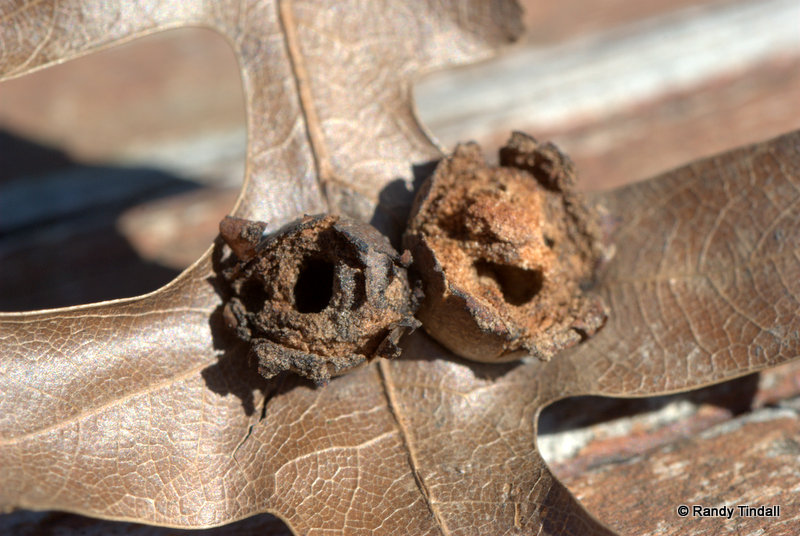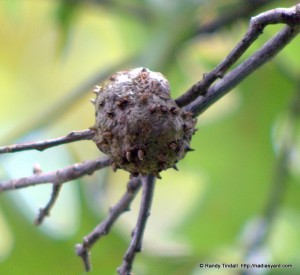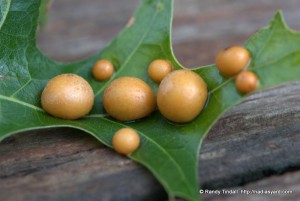NOTE: This posting has an error. The apple-like oak leaf gall is caused by a midge, not a wasp. The leaf gall of the wasp is an elongated gall along the veins of the leaf. I will update the photos at some future time when I can find some good galls. This issue will be discussed in a later post.
The main point of the post is independent of this error, so I have not (yet) rewritten the entire piece. But please be aware of the mistake.
RT
————————————————————————————–
I once read about a researcher in a national park, a field biologist, who said his goal was to “understand” the park, in terms of its ecology. I’m not sure what “understanding” a vast ecosystem meant to him, but I know one of the places he started his search.
Owl barf.
He teased tiny bones and fur and other miniscule clues from the upchucks of nocturnal predators and tried to reconstruct the lives of the puker and the puked and how those lives blended into the vast and intricate matrix of the wilderness. He started his quest for large wisdom from small and humble evidence, because he seemed to believe that all is connected. Start small and large will follow.
How does this work? Well, mouse bones in owl pellets might lead to pondering the habits of wild mice—what they eat, how they reproduce, what else might depend on them for food. If the mice eat certain grass seeds, for example, then we have connected the grass to the owl and to the other connoisseurs of mice, like, maybe coyotes. And if the mouse’s favorite grass grows mainly in mildly wet terrain with a southern exposure to the sun, then we have a connection between grass, owls, coyotes, and mice to the weather, soil drainage patterns, and even the orbit of the earth around the sun and, therefore, the origins of the solar system. And on and on. The trail leads up to the universe and down to the quantum particles of life and matter.
Me? My aims are smaller, or at least the geographic scope of them is smaller. I would like to get some kind of grip on our backyard. The task is no less infinite, but at least I can see from one side of the study area to the other while pondering it in a hammock. I often do that, in fact. Hardly have to turn my head.
Sometimes for days, even weeks, I have trouble thinking of something to write about in our backyard. It’s not for lack of subject matter, because I could never exhaust that no matter how long I tried. Maybe it’s the vastness of it that intimidates me.
Sometimes when I’m stuck I remember something from the book “Zen and the Art of Motorcycle Maintenance”, by Robert Pirsig. Remember that? For years, I’ve been a little ambivalent about this tome, about whether it is a cute piece of pop lit from the 1970’s or if it is a work of real, lasting significance. These days I’m leaning toward the latter.
One part in particular has remained in my mind over the decades. The author as a professor of rhetoric was stymied by his students’ difficulties with finding topics to write about. One girl, in particular, expressed her frustration to him when she couldn’t get started on a 500-word essay she wanted to write on the United States of America. He advised her to narrow it down—write about Bozeman, Montana, he suggested.
She came back later, still frustrated. No good. She couldn’t come up with anything inspiring about Bozeman, Montana. Nothing clicked. Getting increasingly irritated, he told her to pick a street in Bozeman and write about that, for pete’s sake.
She came back again. Same problem. This time he was getting angry and said, “Narrow it down to the front of one building on the main street of Bozeman. The Opera House. Start with the upper left-hand brick.”
The next time she came to see him she was somewhat awed and handed in a five thousand word essay. She said she had “started writing about the first brick, and the second brick, and then by the third brick it all started to come and I couldn’t stop.”
There it is. There are lots of “bricks” in our backyard, from trash-hoarding spiders, to pill bugs that scurry around every time I move a pot or turn the compost, to galls on oak leaves. These are things I can wrap my limited mental capacity around, at least enough to get me started asking a few questions.
Take those galls. I was rummaging around in the backyard the other day and noticed all the old fallen oak leaves with remnants of galls on them. Looking closer, I noticed what must be exit holes caused by emerging wasps leaving their unmade beds behind.
Now, I strongly suspect that these galls were caused by the horned oak gall wasp (Callirhytis cornigera), since the other type of gall they cause on woody tissue has, well, horns, like those I see on our pin oak. This is a two gall wasp, an organism born of two wombs, with two generations leapfrogging into the future. The woody-womb wasp is all female (agamic), and the leaf-womb wasp is the old, reliable sexual model.
Now the problem is, should I write about the next brick over and follow the trail of the alternation of sexual and agamic generations begetting each other down through the ages? What is the evolutionary advantage of this complex strategy? Is there such an advantage (or many), or would something else, something simpler, work just as well? As a graduate student I got used to the attitude that every structure, behavior, and trait of an organism is assumed by many biologists to be “adaptive”, meaning that it leads to more offspring than that species would leave without it. But really? Really? Everything is adaptive? Or not? Pretty soon, I realized, natural selection (evolution) often seemed to be used as the biological equivalent of deity, a convenient explanation for everything observed, a way to mentally tie up unsatisfying loose ends. This deserves a closer look….
Or how about that third brick in the row: the interesting finding that chemical control of these little wasps proved both effective and ineffective. Effective in reducing their numbers immediately, but ineffective in that the treatment also decimated the numbers of another wasp which parasitized the gall wasps, killing the larvae and pupae, and keeping them in check. Although there were fewer wasps all-around after spraying, more of the eggs survived to become mature adults, resulting in a net gain of nada, zip, zero—a fine little lesson in how natural checks and balances should be considered before tinkering. There were just as many “unsightly” galls as before, plus you’re out the cost of the chemicals and application. There’s a wider lesson in there.
Fourth brick: seems that leaf and stem galls don’t just contain the gall wasps that started them, but lots of other things, like moth larvae, ants, spiders, beetles, mites and more. We could get in there and try to unravel that, but I know that I’d just find another wall with a few thousand more bricks to consider. A world in a gall. Worlds in everything.
Fifth brick? Like cicadas, these wasps spend, by far, most of their time out of
sight, in their sealed chambers, absorbing nutrients, working their way through their various phases, engaged in obscure dramas of survival, and lazily dreaming their waspy little dreams of—-what? Months in the leaf galls. Up to three years in the stem galls. Then they pop out, do their procreative stuff for a few days, days mind you, and fade back into the universal murmur. Yet, we refer to the free-flying, free love, stage of cicadas and wasps as the adult phase of their existence. It was all leading up to this, we say. Seems backwards to me in some way. Seventeen years underground for some cicadas and over three years in their cells for these wasps, and we count the brief hours of boisterous buzzing around as the focus of their lives? A question of perspective, methinks.
I think, for me, being blocked isn’t because I can’t think of something to ponder, it’s because I have trouble sometimes grabbing onto a starting place out of the overwhelming totality of what’s there. There’s not much to say about everything, but one can chatter on for hours about the details that make up everything and reflect it like countless little mirrors.
In other words, don’t get me started. Existence is huge. I may never shut up.




